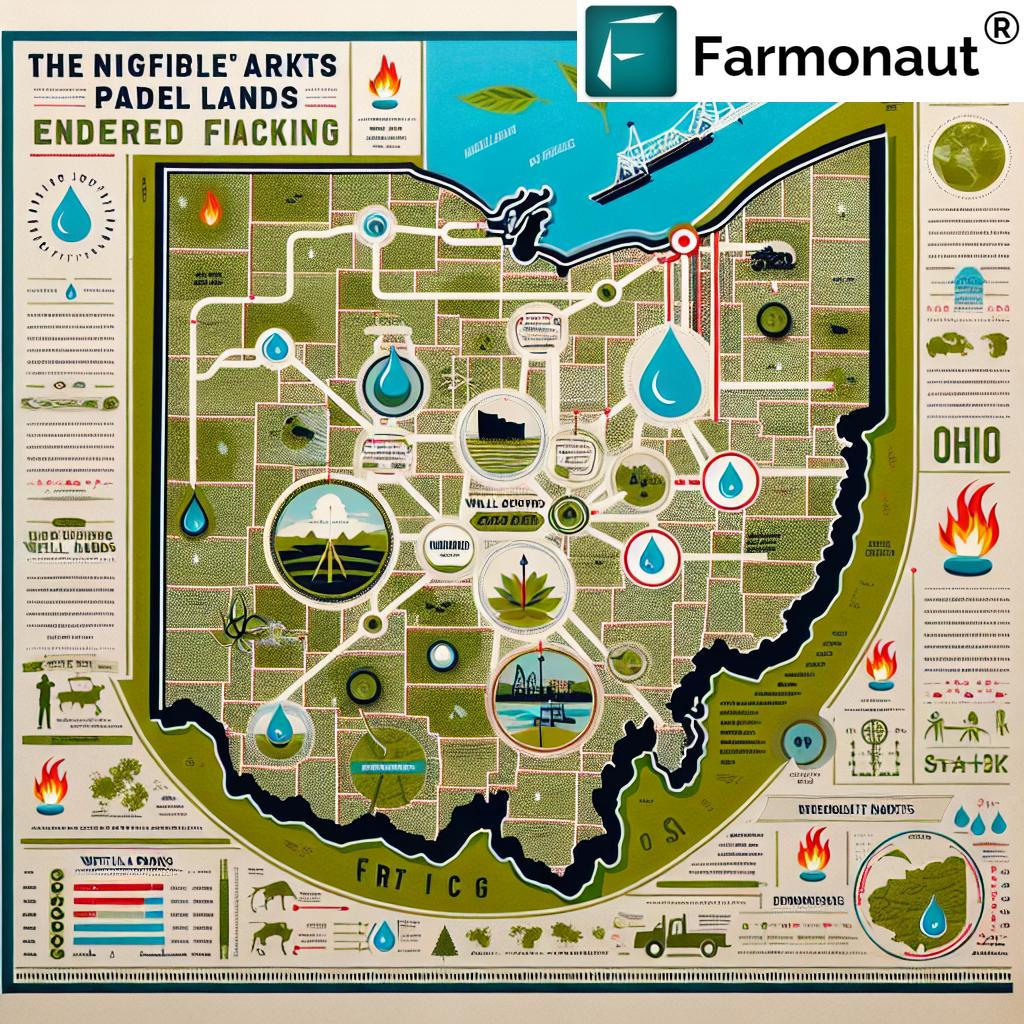Ohio’s Environmental Crisis: The Urgent Need for a Fracking Moratorium in State Parks and Public Lands

“Ohio’s fracking debate intensified after a well pad explosion near a state park, raising safety and environmental concerns.”
As we delve into the critical issue of fracking in Ohio’s state parks and public lands, we find ourselves at a crossroads where environmental conservation, public safety, and energy production intersect. The recent call for a statewide moratorium on fracking activities by Save Ohio Parks and 29 other environmental organizations highlights the urgent need to address the potential risks and long-term consequences of this controversial practice.
In this comprehensive exploration, we will examine the multifaceted aspects of Ohio’s fracking crisis, from environmental impacts to economic implications, and discuss why a moratorium is crucial for preserving our natural heritage and safeguarding public health.
The Current State of Fracking in Ohio
Ohio, known for its diverse landscapes and rich natural resources, has become a hotbed for fracking activities in recent years. The state’s parks and public lands, once sanctuaries for wildlife and recreation, are now facing unprecedented pressure from the oil and gas industry. The situation has reached a critical point, prompting environmental advocates to take decisive action.
On February 10, 2025, a coalition of 30 organizations, led by Save Ohio Parks, sent a letter to Governor Mike DeWine, urging for an immediate moratorium on fracking under Ohio’s state parks and public lands. This call to action was precipitated by a series of concerning events and revelations about the industry’s practices and their potential consequences.
- Lax enforcement of safety regulations
- Use of unregulated and hazardous chemicals
- Underreporting of incidents
- Poor management of radioactive waste
- Lack of comprehensive health studies
- Inadequate emergency planning
The Catalyst: Salt Fork State Park Explosion
The urgency of the situation was underscored by a recent explosion at a well pad near Salt Fork State Park. This incident served as a stark reminder of the potential dangers associated with fracking operations in close proximity to public lands. It raised alarm bells about the safety of visitors, local residents, and the surrounding ecosystem.
Cathy Cowan Becker, president of Save Ohio Parks, highlighted a troubling statistic: since 2015, there has been an average of 250 incidents annually in the oil and gas sector in Ohio – equating to one every 1.5 days. This frequency of accidents paints a grim picture of the industry’s safety record and the potential risks posed to our cherished public spaces.
Environmental Impacts of Fracking
The environmental consequences of fracking extend far beyond the immediate vicinity of well pads. Let’s examine some of the most pressing concerns:
Water Contamination
One of the most significant risks associated with fracking is the potential contamination of water resources. The process involves injecting a mixture of water, sand, and chemicals into the ground at high pressure to fracture rock formations and release oil and gas. This practice can lead to:
- Groundwater pollution from chemical leaks
- Surface water contamination from spills or improper waste disposal
- Depletion of local water supplies due to the massive water requirements of fracking operations
Air Quality Degradation
Fracking operations release various pollutants into the air, including:
- Volatile organic compounds (VOCs)
- Nitrogen oxides
- Particulate matter
- Methane, a potent greenhouse gas
These emissions can lead to poor air quality, contributing to respiratory issues and other health problems for nearby communities.
Habitat Destruction
The development of fracking infrastructure in state parks and public lands can have devastating effects on local ecosystems:
- Fragmentation of wildlife habitats
- Disruption of migration patterns
- Loss of biodiversity
- Soil erosion and sedimentation in waterways

Public Health Concerns
The health implications of fracking activities near populated areas are a growing concern. Studies have linked proximity to fracking sites with various health issues:
- Increased risk of respiratory problems
- Higher incidence of certain cancers
- Adverse pregnancy outcomes
- Stress and mental health issues related to noise and light pollution
The absence of comprehensive statewide health studies on the impacts of fracking in Ohio leaves many questions unanswered and communities vulnerable to potential long-term health effects.
Economic Considerations
While proponents of fracking often tout its economic benefits, a closer examination reveals a more complex picture:
- Short-term job creation vs. long-term environmental costs
- Impact on property values in fracking areas
- Potential loss of tourism revenue in affected state parks
- Costs associated with infrastructure damage and environmental remediation
It’s crucial to weigh these economic factors against the potential long-term costs to public health, environmental quality, and the sustainability of Ohio’s natural resources.
Climate Change Implications
“Fracking in Ohio’s public lands contributes to climate change through methane emissions, a potent greenhouse gas.”
The role of fracking in exacerbating climate change cannot be overlooked. Methane, the primary component of natural gas, is a greenhouse gas far more potent than carbon dioxide in the short term. Leaks and intentional releases of methane during fracking operations contribute significantly to Ohio’s carbon footprint.
As we face the global challenge of climate change, it’s imperative to consider the long-term implications of continuing to expand fossil fuel extraction on public lands.
The Call for a Moratorium
The letter sent to Governor DeWine outlines six primary reasons for the requested moratorium:
- Inadequate enforcement of safety regulations
- Use of unregulated and hazardous chemicals
- Underreporting of incidents (nearly 2,000 from 2015 to 2023)
- Poor management of radioactive waste
- Lack of comprehensive health studies
- Insufficient emergency planning for residents and visitors
These concerns highlight the need for a pause in fracking activities to reassess current practices, strengthen regulations, and prioritize public safety and environmental protection.
The Role of Technology in Sustainable Land Management
As we grapple with the challenges posed by fracking, it’s important to consider how technology can play a role in promoting more sustainable land management practices. Innovative solutions like those offered by Farmonaut can provide valuable insights for environmental monitoring and conservation efforts.
Farmonaut’s satellite-based monitoring technology could be adapted to track environmental changes in areas affected by fracking, helping to identify potential risks and guide remediation efforts. While primarily focused on agricultural applications, such technology demonstrates the potential for data-driven approaches to environmental stewardship.
Public Lands: A Shared Heritage
Ohio’s state parks and public lands are more than just geographical features; they are a shared heritage belonging to all citizens. The current push for industrialization through fracking appears to prioritize short-term gains over the long-term welfare of these precious resources and the communities that depend on them.
Cowan Becker emphasized the importance of maintaining clean air, water, and soil for future generations. The Ohio Department of Natural Resources, tasked with protecting these natural resources, faces scrutiny for potentially falling short of its responsibilities in the face of fracking pressures.
The Path Forward: Alternatives and Solutions
As we consider the need for a fracking moratorium, it’s crucial to explore alternative energy sources and sustainable practices that can meet Ohio’s energy needs while preserving its natural heritage:
- Investing in renewable energy sources like solar and wind power
- Improving energy efficiency in buildings and infrastructure
- Developing green jobs in conservation and sustainable resource management
- Implementing stricter regulations and oversight for existing oil and gas operations
- Prioritizing the restoration and protection of natural habitats in state parks and public lands
Environmental and Economic Impacts of Fracking in Ohio State Parks
| Impact Category | Current Situation | Potential Risks | Proposed Solutions |
|---|---|---|---|
| Water Contamination | Isolated incidents reported | Widespread groundwater pollution | Comprehensive water quality monitoring, stricter waste management regulations |
| Air Quality | Localized air pollution near well sites | Regional air quality degradation, increased respiratory issues | Improved emissions control technology, regular air quality assessments |
| Wildlife Habitat | Fragmentation in fracking areas | Significant biodiversity loss, ecosystem disruption | Habitat restoration projects, creation of protected corridors |
| Public Health | Reported health issues in fracking communities | Long-term health consequences, increased cancer rates | Comprehensive health impact studies, increased healthcare resources in affected areas |
| Economic Benefits | Short-term job creation and revenue | Long-term economic costs outweighing benefits | Investment in sustainable industries, green job creation |
| Climate Change | Increased methane emissions | Acceleration of global warming, extreme weather events | Transition to renewable energy sources, methane capture technologies |
The Role of Public Engagement
The movement to protect Ohio’s public lands from the impacts of fracking underscores the importance of civic engagement and environmental advocacy. The coalition of organizations backing the moratorium represents a diverse cross-section of Ohio’s communities, united in their concern for the state’s natural resources.
Public participation in this debate is crucial. Citizens can make their voices heard by:
- Contacting local representatives and expressing concerns about fracking in public lands
- Attending public meetings and hearings related to land use and energy policy
- Supporting environmental organizations working to protect Ohio’s natural spaces
- Educating themselves and others about the impacts of fracking and alternative energy solutions
Conclusion: A Call to Action
The call for a fracking moratorium in Ohio’s state parks and public lands is not just about environmental protection; it’s about preserving our shared heritage, safeguarding public health, and ensuring a sustainable future for generations to come. As we face this critical juncture, it’s imperative that we carefully consider the long-term consequences of our energy policies and land use decisions.
By prioritizing the protection of our natural resources, investing in sustainable alternatives, and engaging in informed public discourse, we can work towards a future where Ohio’s parks and public lands remain vibrant, healthy ecosystems for all to enjoy. The proposed moratorium offers an opportunity to pause, reassess, and chart a course that balances our energy needs with our responsibility to protect the environment and public welfare.
As this debate continues to unfold, we must remain vigilant, informed, and active in shaping the policies that will determine the future of Ohio’s precious natural spaces. The choices we make today will have lasting impacts on our environment, our communities, and our planet.
FAQ Section
Q: What is fracking, and why is it controversial?
A: Fracking, or hydraulic fracturing, is a technique used to extract oil and gas from deep underground by injecting high-pressure fluids into rock formations. It’s controversial due to potential environmental impacts, including water contamination, air pollution, and increased seismic activity.
Q: How does fracking affect water resources?
A: Fracking can impact water resources through contamination of groundwater with chemicals used in the process, excessive water usage in water-stressed areas, and improper disposal of wastewater.
Q: What are the economic arguments for and against fracking in Ohio?
A: Proponents argue that fracking brings jobs and economic growth to local communities. Critics contend that these benefits are often short-lived and outweighed by long-term environmental and health costs.
Q: How does fracking contribute to climate change?
A: Fracking operations release methane, a potent greenhouse gas, into the atmosphere. This contributes significantly to global warming, potentially accelerating climate change.
Q: What alternatives to fracking are being proposed for Ohio’s energy needs?
A: Alternatives include investing in renewable energy sources like solar and wind power, improving energy efficiency, and developing sustainable resource management practices.
Take Action Today
The future of Ohio’s state parks and public lands is in our hands. By staying informed, engaging with local representatives, and supporting sustainable practices, we can help ensure that these precious resources are protected for future generations. Let’s work together to create a balanced approach to energy production that respects our environment and prioritizes public health and safety.
For more information on sustainable land management and environmental monitoring technologies, visit Farmonaut’s web application or explore their API services.
Earn With Farmonaut: Affiliate Program
Earn 20% recurring commission with Farmonaut’s affiliate program by sharing your promo code and helping farmers save 10%. Onboard 10 Elite farmers monthly to earn a minimum of $148,000 annually—start now and grow your income!
















